

Glow Scotland blog
 Karen Maitland is a teacher of Biology at Queensferry High School in Edinburgh. Karen is an advocate of the use of technology aimed at enhancing the learning and teaching process. In this cookbook Karen will talk us through how she uses Glow to support the learning and teaching of Standard Grade Biology.
Karen Maitland is a teacher of Biology at Queensferry High School in Edinburgh. Karen is an advocate of the use of technology aimed at enhancing the learning and teaching process. In this cookbook Karen will talk us through how she uses Glow to support the learning and teaching of Standard Grade Biology.
Through the appropriate use of technology in class, Karen has aimed to enhance the experience of her pupils during their time in the Biology Department. Through various websites and podcasts, Karen looks to provide her pupils with the opportunity to access advice, information and resources out with the barriers of the traditional school day.
With the introduction of Glow to Queensferry HS, Karen was keen to investigate how best to use the tools and functionality to further enrich the learning experiences of her pupils. In this cookbook, we will hear Karen outline how she has created a Glow Group to act as a one-stop-shop revision source for her Standard Grade Biology class.
Find out more in the Cookbook here
More “Really useful way of teaching the topic, the pupils get really excited about it, when they see the log in screen, even on the smart board they shout Glow, Glow. It is something really exciting for them and it’s brilliant.”
“Really useful way of teaching the topic, the pupils get really excited about it, when they see the log in screen, even on the smart board they shout Glow, Glow. It is something really exciting for them and it’s brilliant.”
Amy Lumsden and Ruth Torrance teach P1A at James Gillespie’s Primary School in Edinburgh. Following introductory training in Glow, Amy and Ruth were keen to investigate if the Glow tools and functionality could support learning and teaching in their class.
Read more on the cookbook here
More Whose Town? is an innovative resource for teaching social studies. It is a fun and interactive digital resource which brings Edinburgh’s history to life. It has been made available to all Glow users and can be found in the Whose Town? Glow Group, you can follow the link from here or from the National Site.
Whose Town? is an innovative resource for teaching social studies. It is a fun and interactive digital resource which brings Edinburgh’s history to life. It has been made available to all Glow users and can be found in the Whose Town? Glow Group, you can follow the link from here or from the National Site.
It is built on the City of Edinburgh’s heritage collections and is linked to the Curriculum for Excellence second, third and fourth levels.
Whose Town? looks at Edinburgh and Scotland’s past from 1850s to the 1950s through the eyes of people who lived there. There are 14 lives to discover who lived in Victorian times, 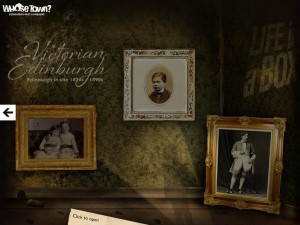 at the beginning of the twentieth century, during the Second World War and in the Fifties. Archival material is collected in a digital box and hidden in an attic for pupils to uncover and examine. Each life is captured at a particular point in history, creating a snapshot of their life: a Life in a Box.
at the beginning of the twentieth century, during the Second World War and in the Fifties. Archival material is collected in a digital box and hidden in an attic for pupils to uncover and examine. Each life is captured at a particular point in history, creating a snapshot of their life: a Life in a Box.
Discover how life was for Levi, a destitute and orphaned boy in late Victorian Edinburgh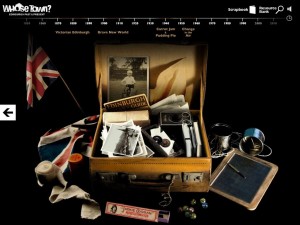 or learn about Robert Louis Stevenson, a young writer studying at Edinburgh University, but destined to travel the world. Learn how nine year old Bessie became the youngest Suffragette or uncover Italian Luca’s story as he established an ice cream business in Musselburgh. Nancy tells what life was like as an evacuee in the country and then as a schoolgirl in a city at war. Hear a first hand account from Hugh about his time working on Edinburgh’s trams in the Fifties or the early days of television from Bill.
or learn about Robert Louis Stevenson, a young writer studying at Edinburgh University, but destined to travel the world. Learn how nine year old Bessie became the youngest Suffragette or uncover Italian Luca’s story as he established an ice cream business in Musselburgh. Nancy tells what life was like as an evacuee in the country and then as a schoolgirl in a city at war. Hear a first hand account from Hugh about his time working on Edinburgh’s trams in the Fifties or the early days of television from Bill.
There are over 450 unique and original documents for teachers and pupils to explore. Maps, newspaper articles, photographs, objects, documents, video and audio clips, and the bits and bobs that everyone collects are all used to bring each person’s history to life. Whose Town? also contains a wealth of support materials for teachers from lesson plans to ideas on how to use archival materials in the classroom. 
Whose Town? is a Heritage Lottery Funded project. It was developed by Edinburgh City Libraries in collaboration with Edinburgh Museums and Galleries and Edinburgh City Archives, and has been supported by many partner organisations.
For more information contact the Digital and Information Team at Central Library in Edinburgh on 0131 242 8047. You’ll also find a wide range of supporting material on Edinburgh City Libraries, Museums and Galleries’ online image library, Capital Collections.
MoreStill Waters
This week’s image was taken by Kyle, an S3 pupil at Wellington Special School, in Edinburgh. The school photography club went up Flotterstone path in the Pentland Hills. Reaching Glencorse Reservoir, Kyle commented on how still the water was and how it seemed to be ‘made of glass’. His photograph was the winning entry in the special school category of the Glow Light competition organised by the Edinburgh Glow team.
The Pentland Hills Regional Park is a living, working landscape, which offers great opportunities to experience and enjoy the outdoors. With approximately 10,000 hectares of countryside and over 100km of paths, the Pentland Hills are a great place to come walking, biking, horse riding as well as fishing.
Outdoor Learning is an important approach in the new Curriculum for Excellence. The Pentland Hills Ranger Service can provide opportunities for schools to participate in enjoyable, active and challenging activities in an outdoor setting which contributes to delivering the Curriculum for Excellence. Curriculum areas include Social Studies, Sciences and Health & Wellbeing. If you would like to know more about what they can offer then please contact the Ranger Service for more information.
Pentland Hills Ranger Service
Regional Park Headquarters
Boghall Farm
Biggar Road
Edinburgh
EH10 7DX
Tel: 0131 445 3383
E-mail: [email protected]
Web Site:www.pentlandhills.org.uk
Text Pentland Hills Ranger Service website.
MoreTrees & Daffodils
This week’s image was taken by Kelly, an S5 pupil at Tynecastle High School in Edinburgh. Kelly said “I was returning home from a course at college and saw the light coming through the trees and thought it would make a good photo”. Her photograph was the winning entry in the secondary school category of the Glow Light competition organised by the Edinburgh Glow team. Originally taken in portrait, it has been cropped for Glow Light.
Harrison Park is a small urban park in Edinburgh, which is well cared for and valued by local people. The park sits alongside the Union Canal, which provides a valuable wildlife corridor in the area.
In 2008 Harrison Park was awarded Green Flag status – one of the first flags issued in Scotland. The scheme aims to encourage safe, clean and accessible public parks which are managed in an environmentally sustainable way.
History of the Park
The eastern part of Harrison Park first came under control of the Corporation in 1886 with a 15 year feu of 13.92 acres from George Watson’s Hospital plus an additional 1.375 acres were feued in 1902 for a bowling green and playground. The park is split in two by Harrison Road, with a playground and football pitches on the east side.
The western portion was purchased for £10,000 from the Merchant Company Education Board on 15 May 1930.
In 2000, North Merchiston Boys Club requested outline planning permission from Edinburgh Council to demolish their current facilities, erect private flats on the premises and build a new sports centre on open parts of the park. Following a campaign from residents surrounding the park, the application was refused. The council then carried out a consultation with surrounding residents and stake holders and came up with a development plan. This resulted in the old bowling green and the tennis courts being removed and turned over to grass.
Text on Harrison Park came from the Friends of Harrison Park website, http://www.harrisonpark.org.uk/, who gave use permission to use any of the text on their website.
MoreBee in Flight
This fantastic photograph is one of three winning entries in Edinburgh’s Glow Light competition. It was taken by Iona, P7, St Mary’s RC Primary. Iona is a member of St Mary’s RC Primary Photography Club. She tells us:
“I was standing with my camera for a long time taking photos of the bees until I finally got one in focus.”
Bees are flying insects closely related to wasps and ants, and are known for their role in pollination and for producing honey and beeswax. There are nearly 20,000 known species of bees in seven to nine recognized families, though many are undescribed and the actual number is probably higher. They are found on every continent except Antarctica, in every habitat on the planet that contains insect-pollinated flowering plants.
Bees are adapted for feeding on nectar and pollen, the former primarily as an energy source and the latter primarily for protein and other nutrients. Most pollen is used as food for larvae.
Bees have a long proboscis (a complex “tongue”) that enables them to obtain the nectar from flowers. They have antennae almost universally made up of 13 segments in males and 12 in females, as is typical for the superfamily. Bees all have two pairs of wings, the hind pair being the smaller of the two; in a very few species, one sex or caste has relatively short wings that make flight difficult or impossible, but none are wingless.
The smallest bee is Trigona minima, a stingless bee whose workers are about 2.1 mm (5/64″) long. The largest bee in the world is Megachile pluto, a leafcutter bee whose females can attain a length of 39 mm (1.5″). Members of the family Halictidae, or sweat bees, are the most common type of bee in the Northern Hemisphere, though they are small and often mistaken for wasps or flies.
The best-known bee species is the European honey bee, which, as its name suggests, produces honey, as do a few other types of bee. Human management of this species is known as beekeeping or apiculture.
Image: Iona, P7, St Mary’s RC Primary, Edinburgh/Text: Wikipedia
More Instead of our usual Glowing Thursdays this week we are going to be hosting a live event from the Royal High School in Edinburgh highlighting the launch of resources developed by the Historical Institute Washington DC and made available through the Goethe-Institut, and Learning and Teaching Scotland to support German History and Culture.
Instead of our usual Glowing Thursdays this week we are going to be hosting a live event from the Royal High School in Edinburgh highlighting the launch of resources developed by the Historical Institute Washington DC and made available through the Goethe-Institut, and Learning and Teaching Scotland to support German History and Culture.
These resources have been selected by the German Historical Institute. They represent a comprehensive collection of original historical sources documenting German history from the Middle Ages to the present day, with particular focus on the period since 1945 to the crumbling of the Berlin Wall during the summer of 1989 and reunification. Within this period, East and West German examples are supplied in order to highlight their similarities and differences. The purpose of these resources is to encourage learners to exercise their intellectual curiosity, ideas and arguments about key issues relating to German history. They also attempt to present an awareness of events and developments, starting with international and domestic politics and extending to economic, social, and cultural issues. Developing cultural awareness is very important in attracting our young people to learning a modern language.
Many of the sources in this selection are difficult to locate in print publications, especially outside of Germany. All of the German language documents are accompanied by contemporary English translations, some of which were commissioned for this project. These resources also provide access to a range of significant visual images, many of which will be unfamiliar outside of Germany.
This part of the launch is aimed at the online audience consisting of teachers of history and German language and will include German Consul Herr Moessinger introducing the resource and there will be a live input via Glow from Dr. Kelly McCullough, Head of the project “German History in Documents and Images”, from the Historical Institute Washington DC.
So why not sign up and join us live at 3.40pm - 4.15pm to listen to Dr McCullough live from Washington DC and Herr Moessinger in the National Modern Languages Glow Group.
Please note that we will be using the new Glow Meet webpart for this event. It is much easier to access and it works in a similar way to the usual Glow Meet so why not give it a go?!
More Calling all Film Fanatics! The 64th Edinburgh International Film Festival invites you to join them for an exclusive Glow Meet on Tuesday 22 June 2010.
Calling all Film Fanatics! The 64th Edinburgh International Film Festival invites you to join them for an exclusive Glow Meet on Tuesday 22 June 2010.
As part of their Media Days for Schools they will be taking a look behind the scenes with two informative and inspiring guests from the UK film industry. These sessions, most suitable for those studying English/Media Studies will run from 1.00pm - 1.45pm and 1.45pm - 2.30pm.
For more information about the Edinburgh International Film Festival please visit www.edfilmfest.org.uk
Join the Edinburgh International Film Festival Glow group to sign up and find out more.

Find us on